Environmental Research About Meatless Monday
Research shows that livestock production contributes more greenhouse emissions and consumes more resources than most plant-based foods.
Food choices have a direct impact on the health of the planet. And while it’s true that all foods need resources to produce, research shows that meat and dairy have the greatest impacts on the environment. Raising animals to feed billions of people requires huge inputs of land, feed, water, and energy for processing, storage, and transport.
The livestock sector, especially beef and lamb production, produces greenhouse gas emissions that cause climate change. Raising livestock also contributes to species decline and the depletion of natural resources like land and water. Shifting diets away from high meat consumption can help reduce these environmental impacts. Meatless Monday is an important first step to encourage consumers to adopt a more sustainable diet.1
Climate Change and Greenhouse Gas Emissions
Nearly 15 percent of global greenhouse gas emissions come from the production of meat, dairy, and eggs. Livestock production produces more greenhouse gases than the world’s entire transportation sector — cars, trucks, planes, trains — combined.2 The majority of those emissions come from cattle in the beef and dairy sector. The emissions associated with producing one quarter pound of beef is about the equivalent of driving a car seven miles or charging a smartphone for six months.3, 4 Shifting towards plant-based diets would help reduce emissions associated with meat production. For example, a plant-based burger has a carbon footprint twelve times smaller than a beef burger.5
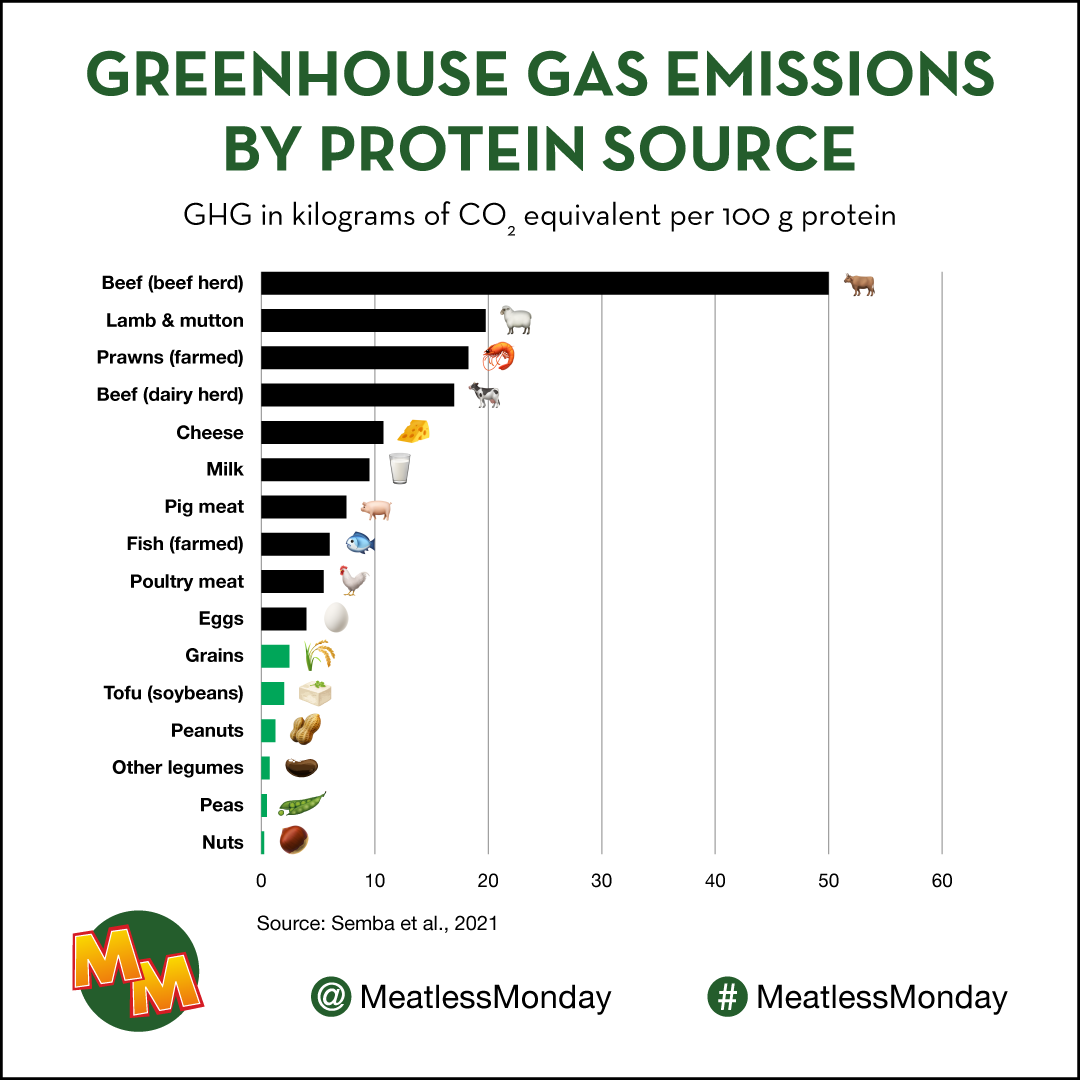

Water
It takes a lot of water to produce meat, especially beef, which has the highest water footprint of all foods. The water footprint of any animal-based food is greater than the water needed to grow most plant-based foods with similar nutritional values. Taking into account all stages of production, one kilogram of beef requires nearly 40 times more water compared to the same amount of vegetables.6 A hamburger made with one quarter pound of beef requires 425 gallons of water to produce.7 The water use primarily comes from growing feed crops, raising the animals, and waste treatment. Eating a more plant-based diet has the potential to decrease agricultural water use by 50 percent.8
Learn more about the water needed to produce 100 common foods using the Water Footprint of Food Guide from FoodPrint.
In addition to the water needed to produce meat, industrial animal agriculture also creates a huge amount of animal waste that can contaminate waterways and cause illnesses in nearby communities. Industrial animal farms often use manure lagoons to capture waste generated by hundreds to thousands of animals. The lagoons can be a source of airborne pathogens that harm nearby residents and wildlife, as well as produce foul smells and insect infestations that lower nearby property values. During heavy rain and flood events, manure lagoons can also overflow, potentially contaminating ground and surface water with huge amounts of feces, associated drugs (such as antibiotics), and chemicals associated with animal production waste.9
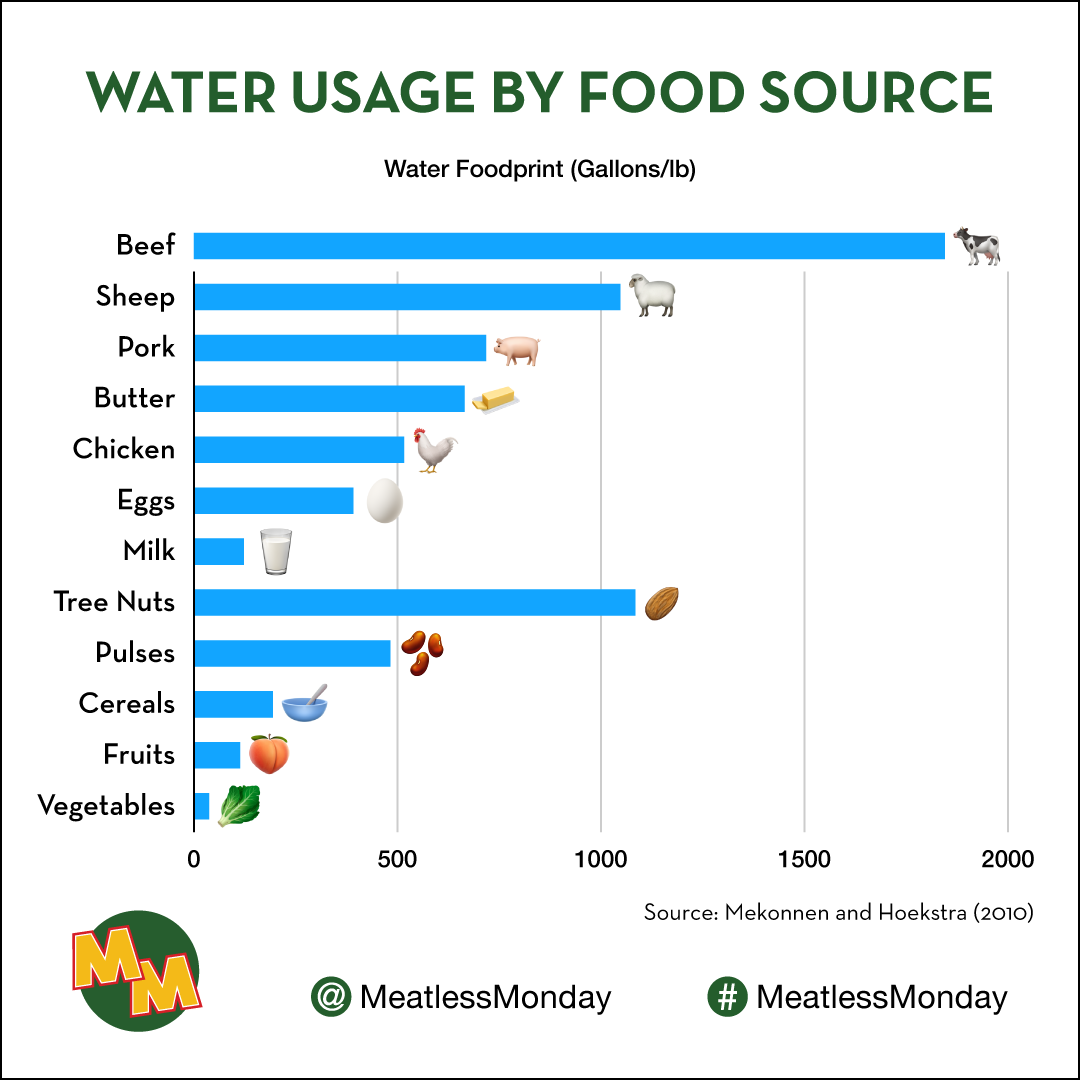

Land Use and Deforestation
The meat industry is the most significant driver of land-use change. Raising animals for meat, dairy, and egg production requires a significant amount of land, leading to deforestation and the loss of other carbon sequestering natural lands. Livestock production uses 75 percent of the earth’s agricultural land, primarily for beef and dairy cattle grazing and growing crops for animal feed.10 Rainforests and other natural lands are cleared for cattle grazing and feed crop production, which further intensifies the carbon impact of animal production. Approximately 13 billion hectares (50 million square miles) of forest area are cleared for agricultural purposes each year. Shifting to a more plant-based diet has the potential to decrease agricultural land use by 80 percent.11
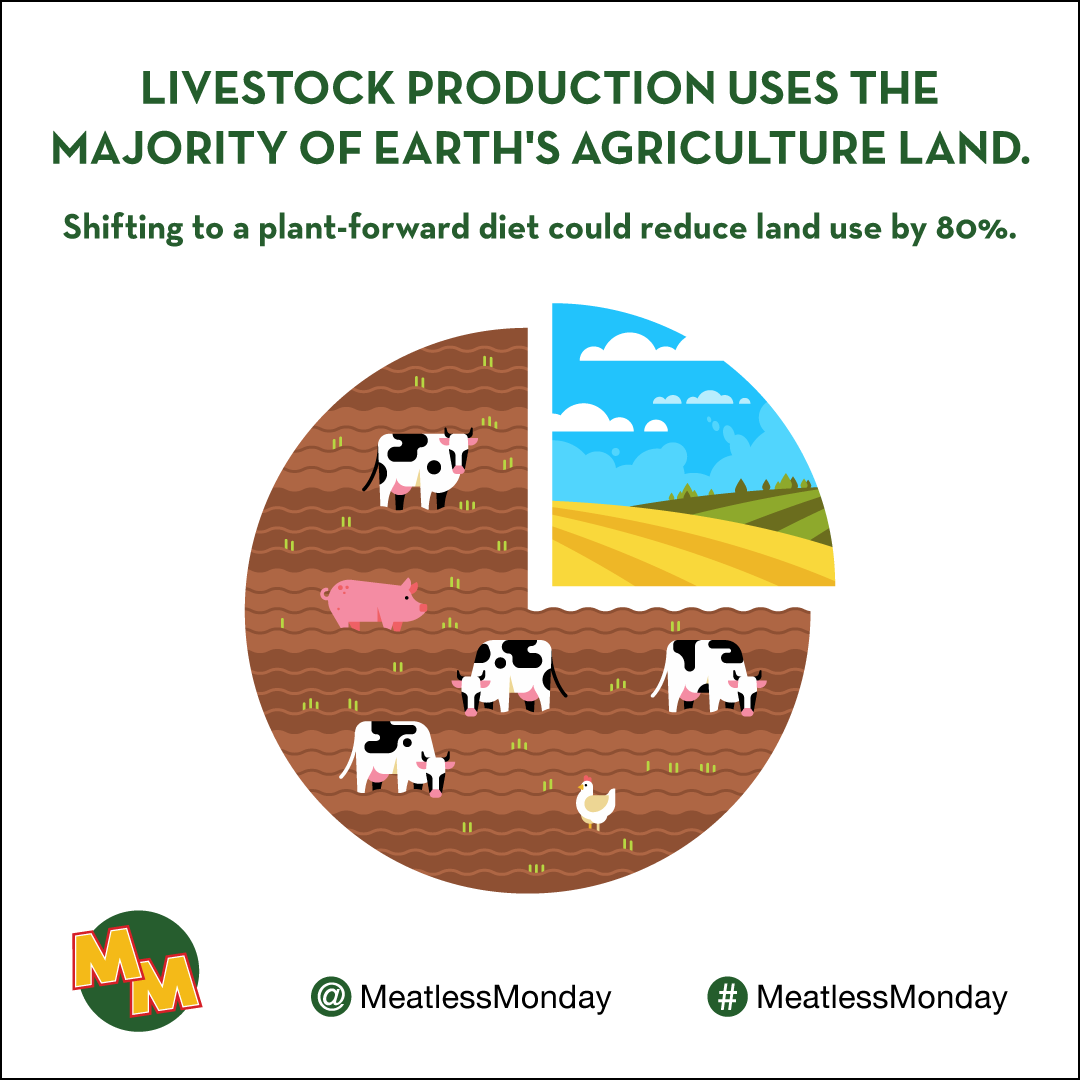

Biodiversity and Species Loss
Livestock production is the biggest human contributor to species decline and has led to over 60 percent decline in species populations since 1970.12 Deforestation destroys the habitat of native birds, reptiles, mammals, insects, and forest fauna resulting in potentially critical population declines. Agricultural intensification and land use change are also responsible in part for the significant reduction in populations of pollinators, like bees, which are needed for the production of crops worldwide.13
While rainforests receive most of the attention, eutrophication is the leading cause of habitat loss globally. Eutrophication is caused primarily by agricultural fertilizer runoff from fields into waterways which creates algae blooms that drive the depletion of the water’s oxygen supply. The lack of oxygen causes ‘dead zones’ in waterways that can kill huge amounts of fish and other aquatic species. Wide-scale dietary shifts from heavy meat and dairy consumption to plant-based diets would provide benefits for soil health and biodiversity.14
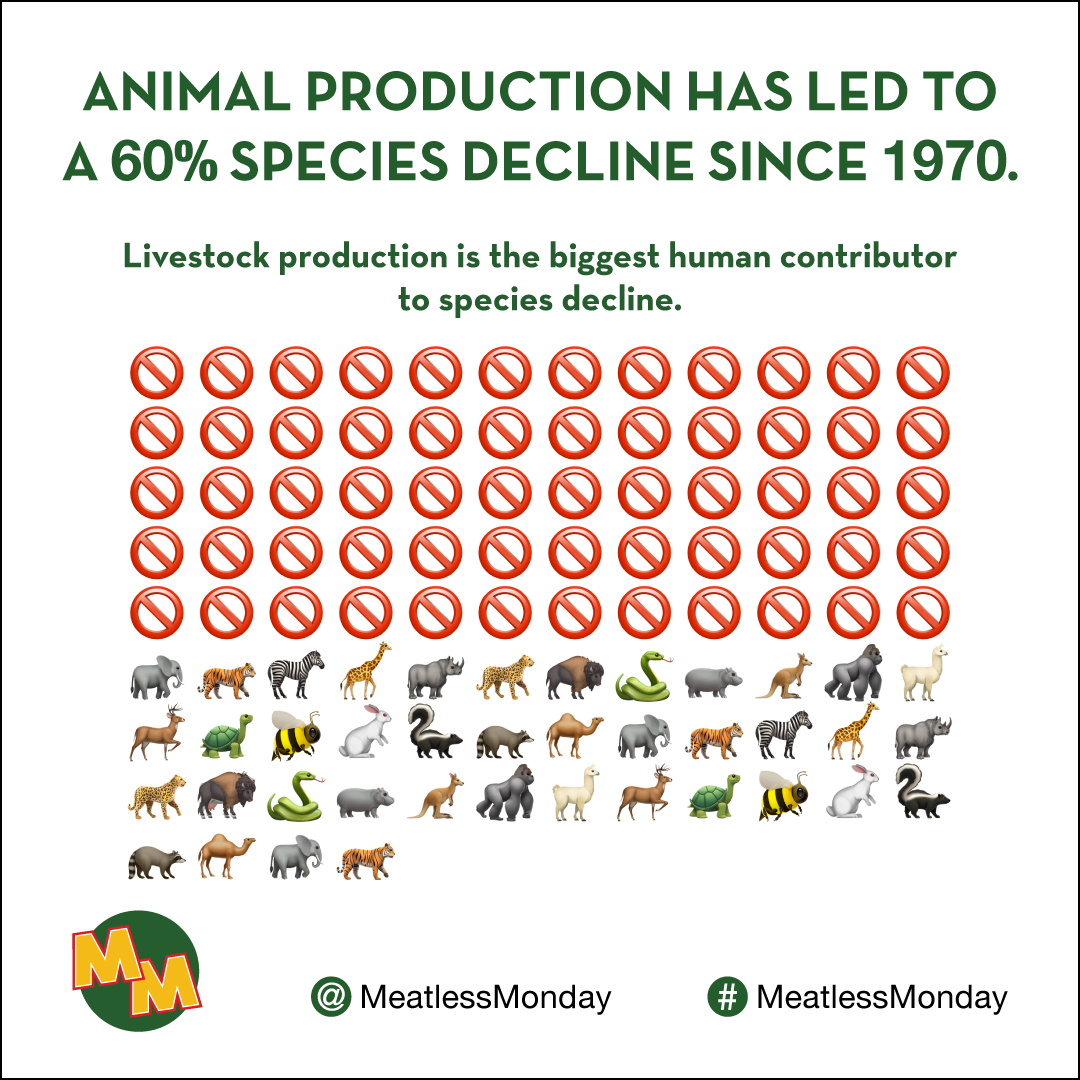

Soil Health
Biodiversity commonly refers to plants and animals, but another important component is soil microbial biodiversity or the soil microbiome. The soil microbiome plays a critical role in soil health, capturing carbon emissions, and reducing climate change impacts.15 Agriculture systems that mimic nature tend to conserve the soil microbiome, while industrial food production and waste from industrial livestock disrupt the soil microbiome and natural cycles that are needed for healthy plant growth and carbon sequestration (capture), which helps mitigate climate change.16 Conserving the biodiversity of soil microbiomes is crucial to ensuring the sustainability, function, and health of our ecosystems.
Industrial agriculture has had significant negative impacts on both the availability and quality of soil. For example, growing single-crop animal feed and raising nearly one billion animals a year for human consumption have substantially contributed to the degradation of global soil health. Nine million hectares of agricultural land are lost to intensive farming each year, leaving previously viable regions unfertile and susceptible to wildfires, flooding, and dust storms.
Further to the negative implications soil degradation has on global food security, the strain on natural resources also reduces its capacity to filter out harmful environmental contaminants, allowing industrial pollutants to enter the atmosphere and waterways. Reducing the amount of land used for animal agriculture by reducing meat and dairy consumption can be an effective way to help protect and restore productivity of soil health. Additionally, increasing global consumption of sustainable plant-based proteins, such as beans and legumes, can actually improve soil health and productivity.17
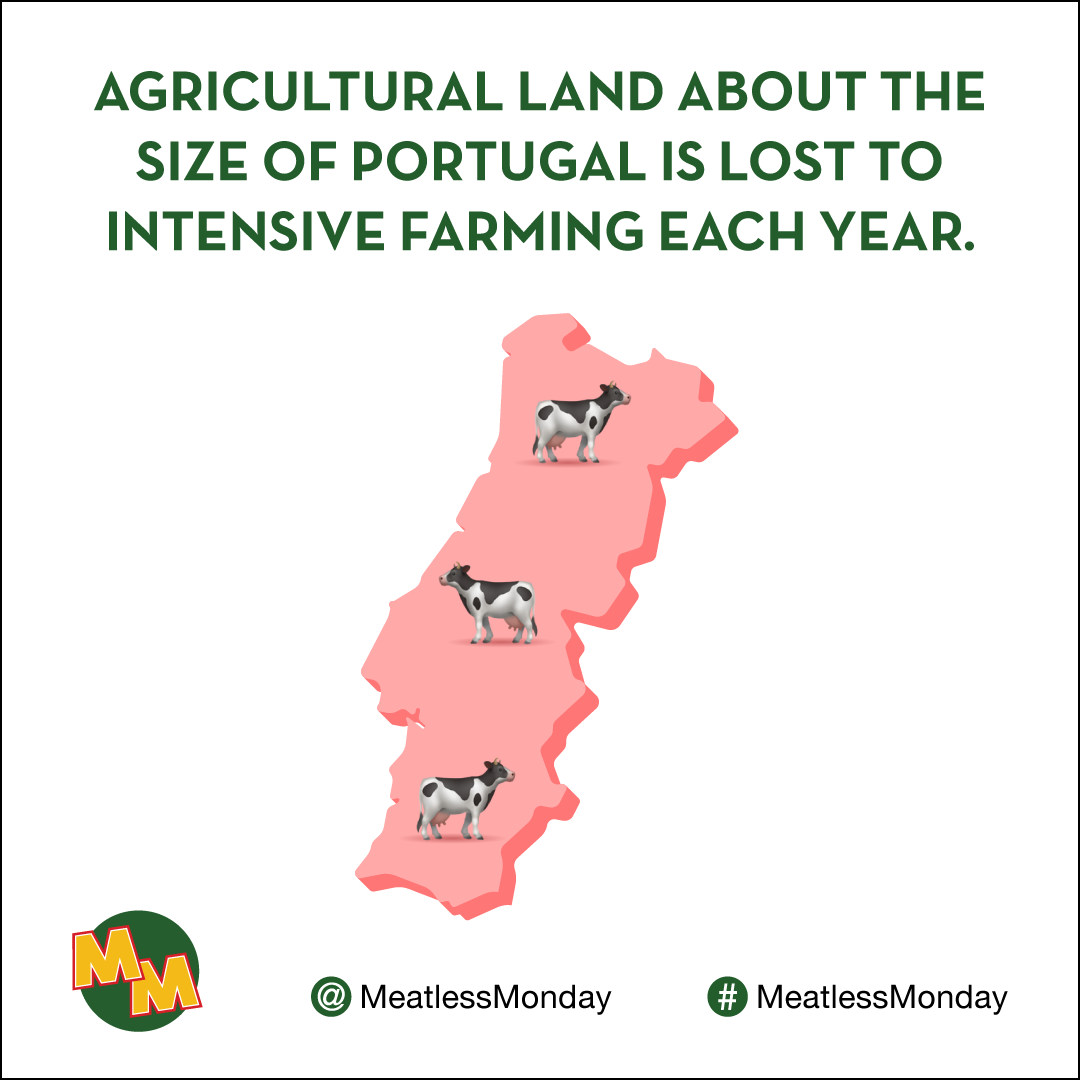

Plant-based Dietary Shifts
Transitioning toward more sustainable, plant-forward diets, especially where meat consumption is high, is one of the most effective actions individuals can take to reduce the world’s environmental footprint. Eating more healthy plant-based foods like beans, peas, lentils, vegetables, and whole grains in place of animal products, like meat and dairy, can help minimize the environmental impact of the food system.
Meatless Monday is an easy way to start a sustainable eating habit and become more familiar with plant-based eating and cooking. Research shows that individuals who participate in Meatless Monday eat more fruits, vegetables, and plant-based meals throughout the week, further benefiting the environment and personal health. As more people around the world begin to embrace a Meatless Monday diet, these small, incremental lifestyle changes will continue to play an increasingly profound role in protecting the health of our global environment and securing a livable future for us all.18
Fast facts on meat, plant-based diet, and the environment
- Eating more plant-based foods is one of the most effective actions individuals in countries with high meat consumption can take to reduce the world’s eco-footprint.
- The meat industry is the most significant driver of deforestation.
- Eating a more plant-based diet could decrease agricultural land use by 80%.
- Eating a more plant-based diet could decrease agricultural water use by 50%.
- Livestock production is the biggest human contributor to species decline.
- The greatest positive impacts of dietary shifts on the environment will come from eating less meat and dairy and more plant-based foods.
- Eating more plant-based foods and less red and processed meats can provide significant health and environmental benefits.
- Eating less dairy and more plant-based foods can provide significant environmental benefits.
- Plant-based dietary shifts would benefit soil health and improve biodiversity.
- Swapping out red meat and dairy one day a week for plant-based foods reduces climate change causing emissions more than eating locally every day.
- If everyone in New York City chose a (soy) veggie burger instead of a ¼ lb. beef burger for Meatless Monday, it would save enough water to fill 79 million bathtubs of water.
- If everyone in New York City chose a (soy) veggie burger instead of a ¼ lb. beef burger for Meatless Monday, it would save the equivalent CO2 emissions from charging 2.6 billion smartphones.
- Livestock production creates more greenhouse gases than the entire transportation sector – all the cars, trucks, planes, and trains in the world – combined.
- Livestock production uses 75% of the earth’s agricultural land.
- Eating less high fat dairy and more plant-based foods can provide significant health and environmental benefits.
Calculate the environmental impact of eating less meat and dairy with this calculator from our friends at Meat Free Monday.
The Johns Hopkins Center for a Livable Future provides technical assistance and serves as a science advisor to the Meatless Monday campaign and provides resources to demonstrate the relationship between food choices and climate change. Additional research reports on the connection between the environment, climate change and food are available from the EAT-Lancet Commission, Intergovernmental Panel on Climate Change, Nature and Climate Policy.
For more tips and resources to join the Meatless Monday movement, visit the Meatless Monday Resources page.
For more information about using a Monday cue to support healthy behavior, visit The Monday Campaigns Research page .
[1] Ramsing, R., Horrigan, L., Berg, P., Fuentes, L. 2019. Meat, Menus and Meatless Monday. Johns Hopkins Center for a Livable Future. https://clf.jhsph.edu/sites/default/files/2019-02/meat_menus_and_meatless_monday.pdf
[2] Gerber PJ, Steinfeld H, Henderson B, et al. Tackling Climate Change through Livestock – A Global Assessment of Emissions and Mitigation Opportunities. Rome: Food and Agriculture Organization of the United Nations; 2013.
[3] Pelletier, N., Pirog, R., Rasmussen, R. (2010) Comparative life cycle environmental impacts of three beef production strategies in the Upper Midwestern United States. Energy Use Agricultural Systems; Volume 103, Issue 6, July 2010, Pages 380-389.
[4] Greenhouse Gas Equivalencies Calculator. U.S. Environmental Protection Agency. https://www.epa.gov/energy/greenhouse-gas-equivalencies-calculator
[5] Top Reasons to Cut Down on Meat and Add More Plant Foods in Your Facility. Johns Hopkins Center for a Livable Future. https://clf.jhsph.edu/sites/default/files/2019-02/top-reasons-to-cut-down-on-meat-and-more.pdf
[6] Water footprint of crop and animal products: a comparison. 2010. Water Footprint Network. https://waterfootprint.org/en/water-footprint/product-water-footprint/water-footprint-crop-and-animal-products/
[7] Mekonnen, M.M. and Hoekstra, A.Y. (2010) The green, blue and grey water footprint of farm animals and animal products, Value of Water Research Report Series No. 48, UNESCO-IHE, Delft, the Netherlands
[8] The Environmental Costs of Meat Production. (2019). Johns Hopkins Center for a Livable Future. https://clf.jhsph.edu/sites/default/files/2019-10/global-meatless-monday-environment_0.pdf
[9] Gaechter, L. 2018. Connecting Agricultural Policy to Your Health: What Do We Do With All This Poop? Report by the Johns Hopkins Center for a Livable Future. September. https://clf.jhsph.edu/sites/default/files/2019-07/connecting-ag-3.pdf
[10] Foley, J. A., Ramankutty, N., Brauman, K. A., Cassidy, E. S., Gerber, J. S., Johnston, M., . . . Zaks, D. P. M. (2011). Solutions for a cultivated planet. Nature, 478, 337. doi:10.1038/nature10452 https://www.nature.com/articles/nature10452
[11] The Environmental Costs of Meat Production. (2019). Johns Hopkins Center for a Livable Future. https://clf.jhsph.edu/sites/default/files/2019-10/global-meatless-monday-environment_0.pdf
[12] ibid.
[13] Grooten M, Almond REA. Living Planet Report: 2018. WWF. 2018. https://www.worldwildlife.org/pages/living-planet-report-2018
[14] The Environmental Costs of Meat Production. (2019). Johns Hopkins Center for a Livable Future. https://clf.jhsph.edu/sites/default/files/2019-10/global-meatless-monday-environment_0.pdf
[15] Hartley, I. P., Hill, T. C., Chadburn, S. E. & Hugelius, G. Temperature effects on carbon storage are controlled by soil stabilisation capacities. Nature communications 12, 6713 (2021).
[16] Lucas, J. M., Sone, B. M., Whitmore, D. & Strickland, M. S. Antibiotics and temperature interact to disrupt soil communities and nutrient cycling. Soil biology & biochemistry 163, 108437 (2021).
[17] The Environmental Costs of Meat Production. (2019). Johns Hopkins Center for a Livable Future. https://clf.jhsph.edu/sites/default/files/2019-10/global-meatless-monday-environment_0.pdf
[18] Semba, R.D., Ramsing, R., Rahmana, N., Kraemer, K., Bloem, M. (2021). Legumes as a sustainable source of protein in human diets. Global Food Security. Volume 28, March 2021, 100520. https://www.sciencedirect.com/science/article/abs/pii/S2211912421000304?via%3Dihub
